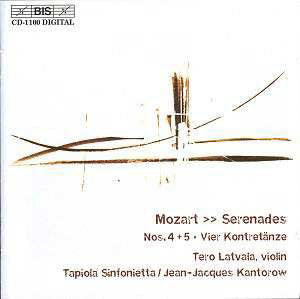A disc of pieces called ‘Serenade’, especially ones with low
Köchel numbers, sounds unlikely to offer a stimulating listening
experience. But if that’s what you’re thinking, stop it, and read on…
These pieces are indeed ‘easy listening’ – they were
intended to be, remember. They’re full of charming ideas, delightful
effects, and naughty surprises which make you smile. True, they’ve got
their fair share of clichés, routine links and obvious phrase
destinations. But over and over again this music also keeps you guessing,
and makes you sit up and take notice: don’t under-estimate it!
K203 has eight movements, while K204 has seven: lots
of tunes for your money! Both pieces feature a solo violinist in movements
II, III and IV, who, though he appears to be sitting in the orchestra
in this recording, enjoys a concerto-like role, complete with virtuosic
cadenzas. Of course these pieces pre-date the five Violin Concertos
proper by a matter of months only. The other movements are notable for
their concertante winds, providing a wealth of unexpected melodic
detail and colour interest.
Most of the disc might appear to be in D major, or
in closely-related keys: certainly, that would be the convention, especially
with horns and trumpets in the orchestra, as here. But, in K203 at least,
Mozart’s tonal scheme ranges wide. Towards the end of the first movement,
precisely where you might expect Mozart to do the traditional thing
– stick around in the tonic key – the music ‘disappears’ into F sharp
minor, only to be grabbed back on to terra firma with (shock,
horror…) a brand new theme in G major. And, most unusually, the three
‘Violin Concerto’ movements of the same Serenade hover around the relatively
distant key of B flat major, thereby creating a significant and welcome
variation in instrumental and harmonic colour.
Textures aren’t always what you might expect either!
Movement VI of K203 – an Andante – consists of a lovely slow-moving
1st violin tune, with harmonic support in the form of a singing viola
countermelody, a simple plodding bass, and – most unusually – an eccentric
2nd violin line made up of buzzing (trilling) semiquavers: the effect
is quite beguiling!
There are adventures in musical structure too! The
concluding movement of K204 – marked Andante (grazioso) - Allegro
– is an extraordinary ‘two-movements-for-the-price-of-one’ structure!
A lyrical Andante movement is overlaid with a dashing triple-time
Allegro, the former variously giving way to the latter and vice
versa, mainly at the structural seams – between exposition and development,
and between development and recapitulation. The nearest thing I’ve encountered
in Mozart (early or late Mozart) is the stop-start structure of the
Rondo of the Piano Concerto No 9 in E flat, K271: such cheeky
musical humour is worthy of Haydn!
The Tapiola Sinfonietta was formed in 1988 and, right
from the outset, aimed to distance itself in terms of repertoire and
sonority from other Finnish municipal orchestras. They certainly appear
to have Mozart in their blood. Jean-Jacques Kantorow (their artistic
director) has them playing like aristocrats: everything is meticulously
shaped and balanced, with a thousand dynamic shadings in evidence. The
winds are truly excellent, and the fine-sounding horn players control
their high-lying parts (in the G major and A major movements)
impressively.
Tero Latvala (their ‘first leader’) obviously enjoys
himself: and the fact that he does so enables us to do likewise! His
cadenzas (which are tasteful but adventurous) were written for him by
the conductor, himself an experienced Mozart violinist.
This beautifully-recorded disc is a treasure. Go serenade
yourself…
Peter J Lawson


![]() See
what else is on offer
See
what else is on offer 